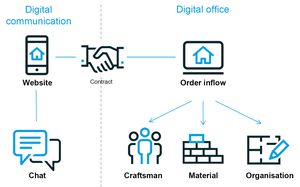KANBrief 2/17

The craft trade sector is characterized by human work much more strongly than industry. The complete automation and networking of all processes seen in Industry 4.0 will therefore rarely be possible. Nevertheless, digitalization also offers the craft trade sector numerous opportunities to extend services, automate tasks, and make work simpler and safer.
The German craft trade sector encompasses a million companies and provides employment to around 5.36 million people. The craft trade sector is extremely heterogeneous, with almost 150 individual trades and with enterprises ranging from microbusinesses to medium-sized companies with several hundred employees. Around half of craft trade businesses in Germany have fewer than five employees.
Digitalization is also impacting substantially upon markets, business processes and occupations in the craft trade sector. ZDH and Bitkom recently conducted a survey of the role already being played by digitalization (German Confederation of Skilled Crafts/Federal Association for Information Technology, Telecommunications and New Media: "Das Handwerk wird digital"). The craft trade businesses see the greatest benefits in optimized storage and distribution of equipment, time savings, and more flexible organization of work. Around a quarter of the businesses are already using digital applications such as tracking systems for stock management, 3D printers and scanners, systems for predictive maintenance, robots or drones. Special software for the management of customer data and projects is in use in one company in two.
Opportunities and challenges for occupational safety and health
The use of technical tools has made numerous tasks in the craft trade sector physically less arduous than in the past. Digitalization will ease the workload even further:
These measures enable work-related physical stresses to be avoided, i.e. overload to be recognized in good time, and prevention measures to be taken. Against the backdrop of demographic change, the extension of working life and the increasing difficulty of meeting the need for skilled staff, craft trade businesses also have an interest in their employees' remaining fit and healthy for as long as possible.
In administration and commerce, during planning tasks and PC-based work in particular, digitalization and electronic networking can also make family and working life more reconcilable. In many traditional craft trade tasks however, the presence of workers will continue to be needed at customers' premises, on construction sites, and in workshops or retail premises. The blurring of boundaries to work that is feared by the trade unions need not therefore be anticipated in the craft trade sector.
One challenge of digitalization is the continual appearance of new work brokering platforms and the associated trend towards sole traders. These sole traders often compete with long-established craft trade businesses. When sole traders, who are subject neither to OSH regulations nor to mandatory retirement pension arrangements, compete with companies whose employees are subject to mandatory social insurance contributions, the gulf between the respective cost structures leads to distortions in competition. Such distortions must be avoided.
A key challenge will be that of finding compromises between companies' need for flexibility and the needs of workers, particularly in the organization of their working hours. The ZDH therefore supports the "experimental spaces" proposed in the white paper on Work 4.0, in which new models of work are trialled and evaluated without bias. What is needed is a new social compromise that reconciles both interests.
Karl-Sebastian Schulte
Managing Director of the ZDH